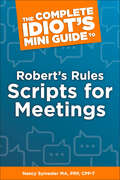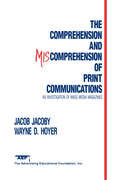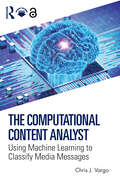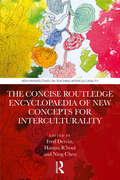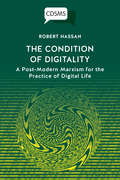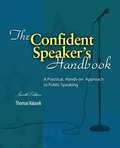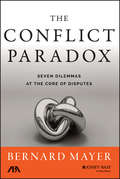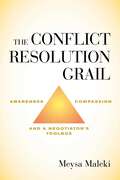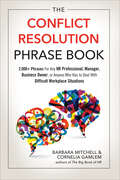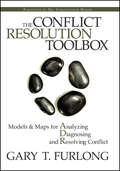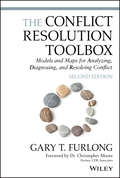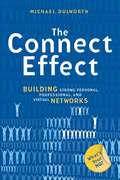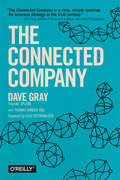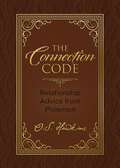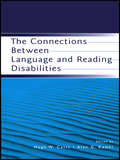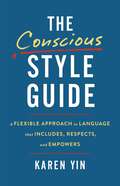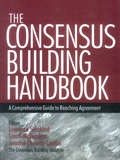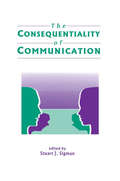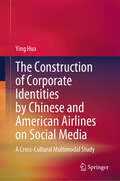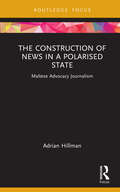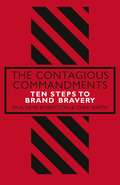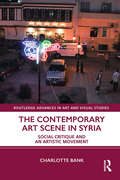- Table View
- List View
The Complete Idiot's Mini Guide to Robert's Rules Scripts for Meetings
by Nancy SylvesterThe whens, hows and whys of keeping order.Robert's Rules have long been the ultimate guide for running meetings and outlining procedures. The Complete Idiot's Guide(r) to Robert's Rules Scripts for Meetings, teaches readers everything from the ladder of motions to how to use Robert's Rules for any size or type of meeting or political caucus.This book includes sample minutes, a sample agenda, and scripts for every type of meeting situations.
The Comprehension and Miscomprehension of Print Communication
by Jacob Jacoby Wayne D. HoyerFirst Published in 1987. To writers and visualizers, this study sets a range of expectations for comprehension and miscomprehension—pointing the finger of caution that even what seems the simplest of language can be misunderstood, but also calling forth their best efforts, because this benchmark study shows that some communications can be much more successful than others and there is usually room for improvement. To advertisers, the study says that perhaps we often take comprehension too much for granted, being satisfied when consumers respond with something in the general area of our message, rather than in the precise area of what is meant. To academicians, the study gives reliable reference points for thought and dialogue among themselves and the advertising and publishing communities. It underlines what intuitive editors and writers have always known but have not always practiced: that words and ideas are fragile—handle with care if you hope to deliver them intact from one mind to another.
The Computational Content Analyst: Using Machine Learning to Classify Media Messages
by Chris J. VargoMost digital content, whether it be thousands of news articles or millions of social media posts, is too large for the naked eye alone. Often, the advent of immense datasets requires a more productive approach to labeling media beyond a team of researchers. This book offers practical guidance and Python code to traverse the vast expanses of data—significantly enhancing productivity without compromising scholarly integrity. We’ll survey a wide array of computer-based classification approaches, focusing on easy-to-understand methodological explanations and best practices to ensure that your data is being labeled accurately and precisely. By reading this book, you should leave with an understanding of how to select the best computational content analysis methodology to your needs for the data and problem you have.This guide gives researchers the tools they need to amplify their analytical reach through the integration of content analysis with computational classification approaches, including machine learning and the latest advancements in generative artificial intelligence (AI) and large language models (LLMs). It is particularly useful for academic researchers looking to classify media data and advanced scholars in mass communications research, media studies, digital communication, political communication, and journalism.Complementing the book are online resources: datasets for practice, Python code scripts, extended exercise solutions, and practice quizzes for students, as well as test banks and essay prompts for instructors. Please visit www.routledge.com/9781032846354.
The Concise Routledge Encyclopaedia of New Concepts for Interculturality (New Perspectives on Teaching Interculturality)
by Fred Dervin Ning Chen Hamza R’boulThis groundbreaking encyclopaedia presents 74 innovative concepts selected and elaborated by multilingual scholars, enriching critical discussions of the notion of interculturality in global scholarship.Many scholars are currently attempting to un-re-think and decolonize interculturality in different fields of research. Although ideas are critiqued and revised, this is happening in very similar linguistic terms as before. These potential attempts to decentre and decolonize could then be put into question. This book argues that knowledge production and negotiation should be exercised through alternative linguistic strategies, not for the sake of sounding different, but to advance new ways of defining, knowing and problematizing. The need to develop concepts in English and other languages is thus promoted in this encyclopaedia.Students, scholars and teachers with a sound background in intercultural studies will benefit most from the book. It will also appeal to anyone wishing to explore new ways of thinking, researching, speaking and writing about interculturality.
The Condition of Digitality: A Post-Modern Marxism for the Practice of Digital Life (Critical Digital and Social Media Studies #2517-1623)
by Robert HassanDavid Harvey’s The Condition of Postmodernity rationalised capitalism’s transformation during an extraordinary year: 1989. It gave theoretical expression to a material and cultural reality that was just then getting properly started – globalisation and postmodernity – whilst highlighting the geo-spatial limits to accumulation imposed by our planet. However this landmark publication, author Robert Hassan argues, did not address the arrival of digital technology, the quantum leap represented by the move from an analogue world to a digital economy and the rapid creation of a global networked society. Considering first the contexts of 1989 and Harvey’s work, then the idea of humans as analogue beings he argues this arising new human condition of digitality leads to alienation not only from technology but also the environment. This condition he suggests, is not an ideology of time and space but a reality stressing that Harvey’s time-space compression takes on new features including those of ‘outward’ and ‘inward’ globalisation and the commodification of all spheres of existence. Lastly the author considers culture’s role drawing on Rahel Jaeggi’s theories to make the case for a post-modern Marxism attuned to the most significant issue of our age. Stimulating and theoretically wide-ranging The Condition of Digitality recognises post-modernity’s radical new form as a reality and the urgent need to assert more democratic control over digitality.
The Confident Speaker's Handbook: A Practical Hands-on Approach to Public Speaking Fourth Edition
by Thomas ValasekThis book is designed to help you become a better public speaker by presenting a practical, hands-on approach to public speaking.
The Conflict Paradox: Seven Dilemmas at the Core of Disputes
by Bernard S. MayerFind the roadmap to the heart of the conflict The Conflict Paradox is a guide to taking conflict to a more productive place. Written by one of the founders of the professional conflict management field and co-published with the American Bar Association, this book outlines seven major dilemmas that conflict practitioners face every day. Readers will find expert guidance toward getting to the heart of the conflict and will be challenged to adopt a new way to think about the choices disputants face,. They will also be offered practical tools and techniques for more successful intervention. Using stories, experiences, and reflective exercises to bring these concepts to life, the author provides actionable advice for overcoming roadblocks to effective conflict work. Disputants and interveners alike are often stymied by what appear to be unacceptable alternatives,. The Conflict Paradox offers a new way of understanding and working with these so that they become not obstacles but opportunities for helping people move through conflict successfully.. Examine the contradictions at the center of almost all conflicts Learn how to bring competition and cooperation, avoidance and engagement, optimism and realism together to make for more power conflict intervention Deal effectively with the tensions between emotions, and logic, principles and compromise, neutrality and advocacy, community and autonomy Discover the tools and techniques that make conflicts less of a hurdle to overcome and more of an opportunity to pursue Conflict is everywhere, and conflict intervention skills are valuable far beyond the professional and legal realms. With insight and creativity, solutions are almost always possible. For conflict interveners and disputants looking for an effective and creative approach to understanding and working with conflict , The Conflict Paradox provides a powerful and important roadmap for conflict intervention.
The Conflict Resolution Grail: Awareness, Compassion and a Negotiator's Toolbox
by Meysa MalekiGlobal conflict is one of the top challenges the world faces today. Our survival as the human race demands that we pay attention to our own role in conflict. Resolving conflict on a global scale requires change at the level of individuals. Lawyer and Mediator Meysa Maleki introduces the everyday person to the elements of conflict, the sub-conversations and the skills that are required to resolve conflict effectively. However, her solution to addressing human conflict goes beyond just the latest conflict resolution theory, negotiation techniques, and the interpersonal skills of a mediator. She draws on the strengths of human beings, their capacity for compassion and their immense potential to change their subconscious programming through awareness. This book weaves together research ranging from human genetics, evolution, communications theory, neuroscience, world history, psychology, and sociology to reframe our understanding of conflict. It provides the everyday person as well as professionals who devote their careers to working with conflict situations with an integrated approach to conflict resolution. Meysa Maleki provides a new paradigm, one that is based on awareness, compassion, and a negotiator&’s toolbox.
The Conflict Resolution Phrase Book: 2,000+ Phrases For Any HR Professional, Manager, Business Owner, or Anyone Who Has to Deal With Difficult Workplace Situations
by Barbara Mitchell Cornelia GamlemA reference to help business leaders and human resources managers dissolve office disputes and foster dialogue with employees.Ouch! Did I really say that? What was I thinking? It’s uncomfortable to go into a tenuous situation blind and fumbling for words. That’s why people run from conflict.Rather than avoid these situations, The Conflict Resolution Phrase Book can help you prepare for and embrace them. Sometimes you just need a prompt to say the right thing, and that’s what this book will do. Using it you’ll learn:Positive things to say when initiating or responding to difficult conversations and situationsHow to find and craft language to start a sensitive conversationThe right words to positively influence the situationThe more you practice, the better you’ll become. Having this book at your fingertips will give you the confidence that the words will come out right. The Conflict Resolution Phrase Book is a natural complement to the author’s previous book, The Essential Workplace Conflict Handbook.“Barbara and Cornelia take the fear out of managing conflict and difficult conversations.” —Adam Bowman, MA. PHR“A ready resource on how to talk differently to get different results when managing conflict. It is a must have for the manager or HR professional.” —Marsha Hughes-Rease, MSOD, PCC, CAPT/NC/USN/Ret., Quo Vadis Coaching and Consulting, LLC
The Conflict Resolution Toolbox: Models and Maps for Analyzing, Diagnosing, and Resolving Conflict
by Gary T. FurlongIn real-life conflict resolution situations, one size does not fit all. Just as a mechanic does not fix every car with the same tool, the conflict resolution practitioner cannot hope to resolve every dispute using the same technique. Practitioners need to be comfortable with a wide variety of tools to diagnose different problems, in vastly different circumstances, with different people, and resolve these conflicts effectively. The Conflict Resolution Toolbox gives you all the tools you need: eight different models for dealing with the many conflict situations you encounter in your practice. This book bridges the gap between theory and practice and goes beyond just one single model to present a complete toolbox - a range of models that can be used to analyze, diagnose, and resolve conflict in any situation. It shows mediators, negotiators, managers, and anyone needing to resolve conflict how to simply and effectively understand and assess the situations of conflict they face. And it goes a step further, offering specific, practical guidance on how to intervene to resolve the conflict successfully. Each model provides a different and potentially useful angle on the problem, and includes worksheets and a step-by-step process to guide the reader in applying the tools. Offers eight models to help you understand the root causes of any conflict. Explains each model's focus, what kind of situations it can be useful in and, most importantly, what interventions are likely to help. Provides you with clear direction on what specific actions to choose to resolve a particular type of conflict effectively. Features a detailed case study throughout the book, to which each model is applied. Additional examples and case studies unique to each chapter give the reader a further chance to see the models in action. Includes practical tools and worksheets that you can use in working with these models in your practice. The Conflict Resolution Toolbox equips any practitioner to resolve a wide range of conflicts. Mediators, negotiators, lawyers, managers and supervisors, insurance adjusters, social workers, human resource and labour relations specialists, and others will have all the tools they need for successful conflict resolution.
The Conflict Resolution Toolbox: Models and Maps for Analyzing, Diagnosing, and Resolving Conflict
by Gary T. FurlongPRAISE FOR THE CONFLICT RESOLUTION TOOLBOX SECOND EDITION "I have been using and recommending The Conflict Resolution Toolbox since its first edition. It is rare to find a resource with such practical tools in a field that is so concrete, but often struggles to bridge theory and practice. In this increasingly complex world, it is vital to have models to resort to when we reach impasse in conflict. I recommend The Conflict Resolution Toolbox to anyone engaged in resolving conflicts in any discipline." —Martha E. Simmons, JD, LLM, PHD, Academic Director, Winkler Institute of Dispute Resolution and Director, Mediation Clinic and Intensive Program, Toronto, Canada "We all know one thing about conflict: It is messy! Furlong's models offer mediators, facilitators, lawyers, psychotherapists and others 'a leg up' in more swiftly figuring out what is going on and what is needed. Furlong does not offer up a single 'truth', style or theory, so much as a collection of effective tools that professionals, groups and families can use to better understand what they are experiencing and how they can approach achieving better results. Highly recommended!" —James C. Melamed, JD, CEO, Mediate.com "Gary Furlong has done it again! A long-time leader in the conflict resolution field, Gary has added two new 'power tools' to what was already the essential conflict resolution toolkit. His new chapters in this Second Edition deal with 'The Law of Reciprocity' and 'Loss Aversion Bias'. I am proud and thankful to add this book to my already growing conflict resolution bookcase, knowing that this is a volume I will go to again and again. I highly recommend it for anyone in the field." —Rick Weiler, Mediator, Arbitrator, Weiler ADR Inc., Ottawa, Canada "Gary Furlong uniquely provides invaluable, practical tools that help in understanding, preventing, and resolving conflict. This is a must-have reference book for anyone who cares about mitigating the role destructive conflict plays in our professional and personal lives and finding strategic benefit in tools that work. Gary has created a book that is both aspirational and practical. It's so challenging to create simple-to-use tools supported by complex concepts and Gary does this better than anyone." —Joshua A. Gordon, JD, MA, Arbitrator for the Court of Arbitration of Sport, Senior Practitioner at the Sports Conflict Institute, and Woodard Family Foundation Fellow Senior Instructor of Sports Business at the University of Oregon Lundquist College of Business
The Connect Effect: Building Strong Personal, Professional, and Virtual Networks
by Michael DulworthEmployment consultant Dulworth instructs how to take a conscious, systematic approach to networking in order to improve personal and professional development skills. After a brief introduction explaining the importance and benefits of networking, he presents a quiz for the reader to determine networking quotient. He then identifies three kinds of networks--personal, professional, and virtual--and examines each for their specific characteristics, further offering strategies, tools, and resources for increasing and making the best use of each network. Two resource-oriented appendices include information on forming a person board for decision-making, and online networking sites. Annotation ©2008 Book News, Inc. , Portland, OR (booknews. com)
The Connected Company
by Dave Gray Thomas Vander Wal<p>To keep pace with today’s connected customers, your company must become a connected company. That means deeply engaging with workers, partners, and customers, changing how work is done, how you measure success, and how performance is rewarded. It requires a new way of thinking about your company: less like a machine to be controlled, and more like a complex, dynamic system that can learn and adapt over time. <i>The Connected Company</i> shows you how.</p>
The Connected Company
by Dave Gray Thomas Vander WalWith a foreword by Alex Osterwalder.The future of work is already here.Customers are adopting disruptive technologies faster than your company can adapt. When your customers are delighted, they can amplify your message in ways that were never before possible. But when your company’s performance runs short of what you’ve promised, customers can seize control of your brand message, spreading their disappointment and frustration faster than you can keep up.To keep pace with today’s connected customers, your company must become a connected company. That means deeply engaging with workers, partners, and customers, changing how work is done, how you measure success, and how performance is rewarded. It requires a new way of thinking about your company: less like a machine to be controlled, and more like a complex, dynamic system that can learn and adapt over time.Connected companies have the advantage, because they learn and move faster than their competitors. While others work in isolation, they link into rich networks of possibility and expand their influence.Connected companies around the world are aggressively acquiring customers and disrupting the competition. In The Connected Company, we examine what they’re doing, how they’re doing it, and why it works. And we show you how your company can use the same principles to adapt—and thrive—in today’s ever-changing global marketplace.
The Connection Code: Relationship Advice from Philemon (The Code Series)
by O. S. HawkinsWe have all experienced disappointment in relationships. Sometimes we wonder if it's even possible to have enduring, positive relationships in our homes, our work, and our communities.In The Connection Code, trusted Bible teacher O. S. Hawkins digs deep into the biblical book of Philemon to give us a blueprint for building life-giving relationships in every sphere of our lives. This tiny book in the New Testament is a letter the apostle Paul wrote to a wealthy businessman named Philemon on behalf of his escaped bond servant, Onesimus. Containing only 22 sentences, the book of Philemon unlocks the code to forging interpersonal connections that stand the test of time.With the practical and thoughtful Bible teaching he's known for, Dr. Hawkins reflects on every verse in Philemon in light of our relationships today. Following the style of the bestselling Code Series, The Connection Code explores:The three critical relationships each of us needHow to let others know we believe in themWhy a win-win perspective is crucial for friendshipsHow true commitment always includes forgivenessWhy finding our self-worth in Christ empowers us to love others well If you long for deep, authentic friendships in a superficial world, discover what God's plan has always been for building relationships that last in The Connection Code.
The Connections Between Language and Reading Disabilities
by Alan G. Kamhi Hugh W. CattsThis is an edited book based on papers presented at a 2003 invitee-only conference under the sponsorship of the Merrill Advanced Studies Center of the University of Kansas. The participants were prominent scholars in the areas of language and reading, and have research programs funded by NIH and other sources. The purpose of the gathering was to discuss theoretical issues and research findings concerning the relationship between developmental language and reading disabilities, specifically looking at neurological, behavioral, and genetic factors. In addition, it discussed other factors contributing to reading difficulties in the middle elementary school years through adolescence and literacy outcomes for children with early language impairments, and how these problems relate to children with dyslexia. The Foreword is written by Reid Lyon, Branch Chief, Child Development and Behavior Branch, NICHD-National Institutes of Health.This book appeals to scholars in the areas of language disorders and reading disabilities, as well as to practicing speech-language pathologists, special educators, and reading specialists. It may also be used in graduate courses designed as seminars in either language disorders or reading disabilities in schools of communication disorders, as well as schools of education--especially special education departments.
The Conscious Style Guide: A Flexible Approach to Language That Includes, Respects, and Empowers
by Karen YinA timeless, indispensable guide for anyone who wants to communicate with sensitivity and compassion. Most of us want to choose inclusive, respectful, and empowering language. But language—and how we use it—continually evolves, along with cultural norms. When contradictory opinions muddle our purpose, how do we align our word choices with our beliefs? Who has the final say when people disagree? And why is it so hard to let go of certain words? Afraid of getting something wrong or offending, we too often treat words as dos or don&’ts, regardless of context and nuance. Thankfully, in The Conscious Style Guide, award-winning editor Karen Yin provides a road map for writing and speaking with equity in mind—no matter how the world around us changes. Readers will learn: How to identify biased language How to use inclusive language to bring attention to specific groups of people How to adopt conscious language as a tool for self-awareness and critical thinking How to make digital materials more accessible, from event flyers to websites How to alleviate the stress of experiencing exclusionary language How to collaborate with others and work across differences How to create a style sheet to help support your practice And much more With practical advice and hundreds of relatable examples, The Conscious Style Guide invites us to challenge binary thinking, embrace flexibility and creativity, and explore truly effective communication—in all aspects of our lives.
The Consensus Building Handbook: A Comprehensive Guide to Reaching Agreement
by Sarah McKearnen Jennifer Thomas-Lamar Lawrence E. SusskindWhether you work in the corporate world, a nonprofit organization, or the government sector, you likely face the need to work with others to solve problems and make decisions on a daily basis. And you′ve undoubtedly been frustrated by how laborious and conflict-ridden such group efforts can be. At all levels – from neighborhood block associations to boards of directors of multinational corporations – the consensus building process is highly effective in an increasingly fragmented, contentious society. In addition, the old top-down methods such as Robert′s Rules of Orders often prompt more problems then they solve. Consensus helps you to implement better, more creative solutions. It provides a winning alternative to top-down decision making – and even parliamentary procedure. By learning to build consensus, stakeholders come to understand and respect one another′s perspectives. The consensus building process allows participants to find solutions and forge agreements that meet everyone′s needs – and provides a meaningful basis for effective, long-range implementation of decisions. The Consensus Building Handbook provides a blueprint to help make the process work in your organization, including a practical, quick-reference Short Guide. Plus, you′ll find in-depth commentary and seventeen case studies with in-depth commentaries to provide the theoretical basis for this new approach. CASE STUDIES INCLUDE: Activating a Policy Network: The Case of Mainport Schiphol The Northern Oxford County Coalition: Four Maine Towns Tackle a Public Health Mystery The Chelsea Charter Consensus Process Resolving Science-Intensive Public Policy Disputes: Reflections on the New York Bight Initiative Negotiation Superfund Cleanup at the Massachusetts Military Reservation RuleNet: An Experiment in Online Consensus Building Regulatory Negotiations: The Native American Experience The Chattanooga Process: A City′s Vision Is Realized From City Hall to the Streets: A Community Plan Meets the Real World The Catron County Citizens Group: A Case Study in Community Collaboration Facilitating Statewide HIV/AIDS Policies and Priorities in Colorado Building Consensus for Change Within a Major Corporation: The Case of Levi-Strauss & Company
The Consequentiality of Communication (Routledge Communication Series)
by Stuart J. SigmanIn a bold attempt to redirect the ways theories of communication are conceived and research on communication processes are conducted, this volume questions prevailing communication scholarship that emphasizes the cultural, psychological, and sociological variables that impact on, and/or are impacted by, communication. Instead of focusing on the consequences of communication, this books urges readers to examine the consequentiality of communication -- what it is about the communication process that enables it to play a defining role in our lives. Communication is not a neutral conveyor of meanings derived from culture, cognition, or social structure, and is not explained by correlations with external variables. Meaning emerges from the communication process itself; it is dependent upon what transpires during the real-time moments of communicators behaving with each other. To properly study this new paradigm, a new vocabulary for thinking about the consequentiality of communication is needed and proposed. Four theoretical orientations are used to stake out this new territory: coordinated management of meaning, neo-rhetorical theory, conversation analysis, and social communication theory. While there are points of agreement and overlap on the need to study communication as inherently consequential, there are also differences across the four theories -- in the value of "rules" as an explanatory concept, on the relationship between structure and process, and on the very constitution of a "theory." Thus, this book has the benefit of articulating a new paradigm for communication scholarship without losing sight of the discipline's rich diversity.
The Construction of Corporate Identities by Chinese and American Airlines on Social Media: A Cross-Cultural Multimodal Study
by Ying HuaUsing top Chinese and American airlines as examples, this book approaches the construction of corporate identities on social media, a critical issue in corporate communication, from a cross-cultural multimodal perspective. Through a holistic and systematic multimodal analysis, it provides a comprehensive cross-cultural understanding of corporate identity construction on social media. By developing an integrated social semiotic framework based on registerial cartography in SFL, it investigates the airlines’ registerial activity patterns in terms of macro-level configuration and micro-level multimodal realizations, interprets their situated contextual patterns that delineate the construction of corporate identities and further explains the influence of cultural factors. Given that this book offers theoretical contributions to corporate identity and cross-cultural communication research, practical guidance on PR practices, especially in the context of Chinese enterprises going global, and pedagogical insights for business communication courses, this book will be of particular benefit to researchers in linguistics, management and communication studies, PR practitioners, and both lecturers and learners of business communication courses.
The Construction of News in a Polarised State: Maltese Advocacy Journalism (Routledge Focus on Communication and Society)
by Adrian HillmanTaking a qualitative approach based on original case studies, this book offers a detailed overview of the contemporary media system in Malta. Three Maltese news organisations are examined to understand the editorial routines, ownership and management structures, and social and cultural factors that affect the day-to-day business of creating news. In-depth interviews with key stakeholders of each organisation are conducted alongside qualitative textual analysis of the content they publish. Contrary to previous research, the work finds that advocacy continues to dominate Maltese journalism, indicating that the country has retained similarities to other media systems within its geographic region. While recognising that the gold standard in journalism is judged to be objectivity and balance, a case is made for a responsible, measured form of advocacy journalism to extend media diversity and contribute to a high level of national political engagement. Presenting an informed case for the need to pay closer attention to small states, especially at a time when many countries are seen to be becoming increasingly socially and politically divided, The Construction of News in a Polarised State is an insightful text for scholars and academics in the fields of media and communication studies, political science, and sociology.
The Contagious Commandments: Ten Steps to Brand Bravery
by Paul Kemp-Robertson Chris BarthContagion may alarm doctors but marketers thrive on it. Some concepts are so compelling you have to share them. But what makes an idea so infectious you can't keep it to yourself? And how can brands produce these kinds of ideas intentionally rather than by chance?Contagious, the globally renowned intelligence resource for the marketing industry, is dedicated to identifying and interrogating the world's most exceptional creative trends. And in The Contagious Commandments, Paul Kemp-Robertson and Chris Barth condense this valuable research into ten strategic takeaways for your own marketing revolution.Taking inspiration from disruptive campaigns from the likes of Patagonia, Nike, Safaricom, BrewDog, LEGO, Kenco, and dozens more, The Contagious Commandments explores how companies fuse creativity, technology and behavioural psychology to achieve truly original marketing ideas that have a positive impact on society and profits - and how your brand can too.
The Contemporary Art Scene in Syria: Social Critique and an Artistic Movement (Routledge Advances in Art and Visual Studies)
by Charlotte BankThis book focuses on the expanding contemporary art scene in Syria, particularly Damascus, during the first decade of the twenty-first century. The decade was characterized by a high degree of experimentation as young artists began to work with artistic media that were new in Syria, such as video, installation and performance art. They were rethinking the role of artists in society and looking for ways to reach audiences in a more direct manner and address socio-cultural and socio-political issues. The Contemporary Art Scene in Syria will be of interest to scholars of global and Middle Eastern art studies, and also to scholars interested in the recent social and cultural history of Syria and the wider Middle East.
The Contemporary Reception of Classical Rhetoric: Appropriations of Ancient Discourse (Routledge Communication Series)
by Kathleen E. WelchResponding to the reassertion of orality in the twentieth century in the form of electronic media such as the telegraph, film, video, computers, and television, this unique volume traces the roots of classical rhetoric in the modern world. Welch begins by changing the current view of classical rhetoric by reinterpreting the existing texts into fluid language contexts -- a change that requires relinquishing the formulaic tradition, acquiring an awareness of translation issues, and constructing a classical rhetoric beginning with the Fifth Century B.C. She continues with a discussion of the adaptability of this material to new language situations, including political, cultural, and linguistic change, providing it with much of its power as well as its longevity. The book concludes that classical rhetoric can readily address any situation since it focuses not only on critical stances toward discourse that already exists, but also presents elaborate theories for the production of new discourse.
The Contemporary Small Press: Making Publishing Visible (New Directions in Book History)
by Georgina Colby Leigh Wilson Kaja MarczewskaThe Contemporary Small Press: Making Publishing Visible addresses the contemporary literary small press in the US and UK from the perspective of a range of disciplines. Covering numerous aspects of small press publishing—poetry and fiction, children’s publishing, the importance of ethical commitments, the relation to the mainstream, the attitudes of those working for presses, the role of the state in supporting presses—scholars from literary criticism, the sociology of literature and publishing studies demonstrate how a variety of approaches and methods are needed to fully understand the contemporary small press and its significance for literary studies and for broader literary culture.
